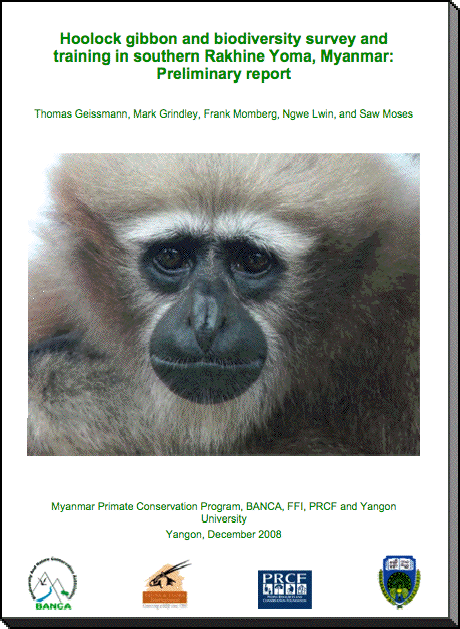Geissmann, T.,
Grindley, M., Momberg,
F., Ngwe Lwin, and Saw Moses (2008). Hoolock gibbon and
biodiversity survey and
training in southern Rakhine Yoma, Myanmar: Preliminary report,
Myanmar Primate
Conservation Program, BANCA, FFI, PRCF and Yangon University, Yangon,
Myanmar. 31
pp.
 |
Hoolock gibbon and biodiversity
survey and training in southern Rakhine Yoma, Myanmar: Preliminary
report
Geissmann, T., Grindley, M.,
Momberg, F., Ngwe Lwin, and Saw Moses
Myanmar Primate Conservation
Program, BANCA, FFI, PRCF and Yangon University, Yangon, Myanmar. 31 pp.
You can download this
publication as a PDF file (1.9 MB).
Download begins if you click here.
|

Abstract
This is a report on a training course
introducing
the methodology to be used in the Hoolock Gibbon Status Review project
(of the Myanmar
Conservation Program), which was field tested on a short hoolock gibbon
and biodiversity
survey in southern Rakhine Yoma, south-west Myanmar. The survey served
to fine-tune
skills learned by course participants, and as a test run for the
project which aims
at assessing the status of the hoolock gibbons (genus Hoolock)
in Myanmar.
Although the country still holds large intact areas of prime gibbon
habitat and is
believed to support the largest remaining populations of hoolock
gibbons, there is
no significant data on the conservation status of the species in
Myanmar. This first
survey was carried out during the dry season (November 2008) in
southern Rakhine
Yoma. The study confirms the occurrence of hoolock gibbons in what
appears to be
the southernmost locality recorded so far, and supports their
identification as Western
Hoolock Gibbon (Hoolock hoolock). Hoolock gibbons were confirmed
present in
very low densities, and several possible explanations for this finding
are discussed.
However, the main reason for the low density is believed to be low
habitat quality.
As a further result of the survey, several mammal and bird species were
confirmed
for the first time for this region of Myanmar, and a potentially new
fish species
was observed.

|
Contents
|
| |
| Abstract |
| |
| Introduction |
Hoolock gibbons
Background to the project
|
| |
| Materials and methods |
Training
Field survey area
Interview survey methods
Field survey
Mapping and density determination
|
|
| Results 1: Interview
survey |
Farming system
Livestock
Forest resource use
Other income from labour
Wildlife conflicts
Development initiatives
Threats to forests/ habitat
Threats to wildlife
|
| |
| Results 2: Field survey |
Gibbons
Other mammals
Birds
Other animals
|
|
| Conclusions |
| |
| Acknowledgements |
| |
| References |
| |
| Appendices |
Appendix 1.
Hoolock Gibbon and Biodiversity Conservation project: Observation sheet
Appendix 2. Birds recorded during the survey
Appendix 3. Daily bird records during the survey
|
|

| |
Site by Thomas Geissmann.
For comments & suggestions, please email to
webmaster@gibbons.de
Gibbon Research
Lab. Home: |
 |
|

|
